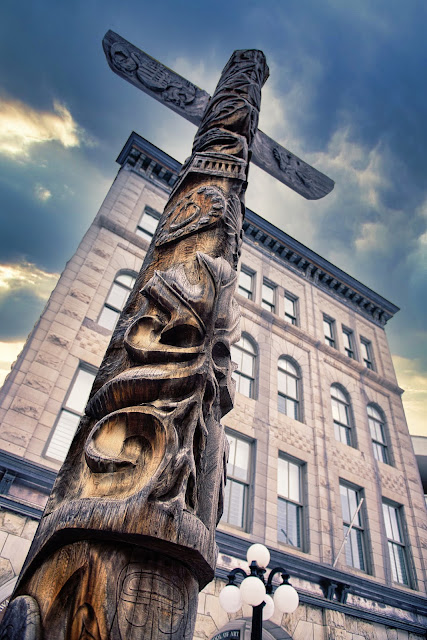Don't Wait for the Perfect Sky
I used to say that I loved overcast skies when photographing the outdoors. The clouds are a great diffuser, eliminating unwanted, harsh shadows from your subjects. But what if the sky is the background of your subject or is, indeed, your actual subject?
There have been countless times that I have shot subjects to find that the sky is either blown out from harsh sunlight or, in the case of overcast skies, flat and lifeless.
In post-processing, I have used highlight recovery features in attempts to bring some definition to the sky. I have also pulled back on highlights to do the same thing. But rarely to I get the results that I've wanted.
On Monday, I wrote about how DW bought some new photo-editing apps: some, for herself, so that she could play with the competition to her company's software. But she also bought an app for me, for Christmas, to add to my arsenal of editing software.
In Monday's post, I showed the different results that I got from our various apps—Affinity Photo, Luminar AI, On1 Photo RAW 2021, and Corel PaintShop Pro (2016 and 2021)—and overall I found that I still liked PaintShop Pro the best, though I did like the preset filters and special effects of Luminar AI.
(For Wednesday's post of purple finches, however, I used Affinity, just to compare with PSP.)
For regular post-processing of my photos, I'll likely continue to use PSP. I'm most familiar with it, and as Monday's photos showed, I seemed to get some of my best results (as many of my Twitter friends attested).
As I continued to acquaint myself with Luminar AI, I found a feature that seems to solve some of my issues with blown out or flat skies, and while I won't rely on this cheat for the majority of my photos, it's a nice special-effects feature that can transform a photo.
When I want to manipulate a photo to create a particular mood, I have turned to Luminar's templates, such as sunsets, city lights, and nature, which can manipulate the amount of light, highlights, contrast, colour saturation and luminosity, and other aspects of the photo. From there, I will further tweak the settings, in the Edit mode, to suit my own preferences.
But there is a creative mode that really brings out the AI capabilities with this program, and I have used it when I've found that the sky in my photos is lacking. Luminar's AI lets you change the appearance of the sky and even add elements that aren't there. You can add the Milky Way. A bright-blue sky. A sunset.
You can enhance your sky with birds, balloons, fireworks, or planets. You can change an ordinary photo into one of fantasy and pure fiction.
In playing with these features, I used some recent photos that I shot during my holiday break. DW and I went to the ByWard Market on December 30, which was a grey, overcast day. To show you what the day actually looked like, here's the untouched photo, taken straight from RAW.
Playing with Luminar AI, I decided to add a dramatic sky that showed blue and individual clouds. Here's the result:
Standing below the totem pole that towers in front of the Ottawa School of Art, the sky was a blank canvas of pale grey, almost white. To it, I added a dramatic sunset sky.
And again, in front of the iconic Market building, there wasn't much of a sky until I played with the creative effects.
In the Jeanne d'Arc Court, I went a bit overboard, adding a dramatic sky and birds. Because my subject was some of the surreal artwork in this court, I thought I'd make a surreal sky. To me, this photo could be used as an album cover. Thoughts?
Finally, on last weekend's trek around the Fletcher Wildlife Gardens and the surrounding trails, I took a photo of the barn that lies along Prince of Wales Drive. It was in the distance and I could see it through some trees, along a path. Using my telephoto lens, I captured the image and told myself it was going to be a keeper.
I shot the photo as the sun was sinking toward the horizon, and my eye, through the camera's viewfinder, could pick up a bit of a yellow glow. But when I saw the RAW image, the light in the background was blown out. I decided to use Luminar AI with my post-processing, applying one of the sunset templates to bring back the warm glow that I had seen when I shot the photo.
It helped a bit, but not quite enough. What I saw through the viewfinder was not quite there. So I switched to the creative mode and added a sunset sky. To further bring out what I saw, I added just a touch of sunrays. In doing so, however, I had now placed the sun in the shot, through the trees, and I was certain the sun was just out of the frame when I shot it.
Oh well. The result is that the barn looks close to what I saw through the lens, though the sky is more exaggerated.
But one thing is certain: the photo is better than how it looked in its RAW format.
I've played with these features to see what Luminar AI can produce. And while I admit that some of the results are over-the-top, I will use them sparingly and, hopefully, in a way that doesn't take away from the basic essence of the photograph.
But having this tool in my box of photo-editing tricks, I know that I don't have to wait for the perfect sky to capture an image.
Happy Friday!










Comments
Post a Comment